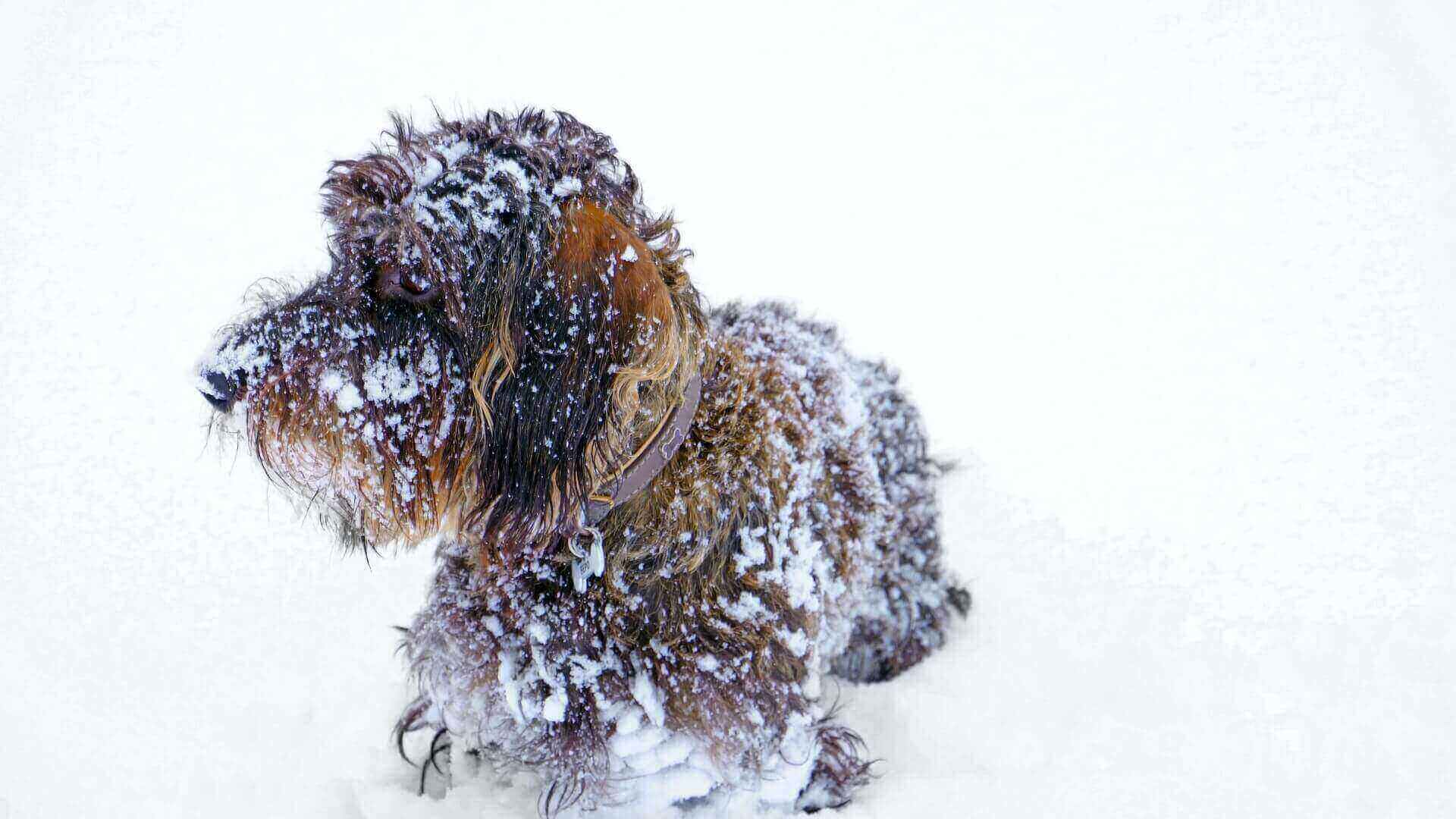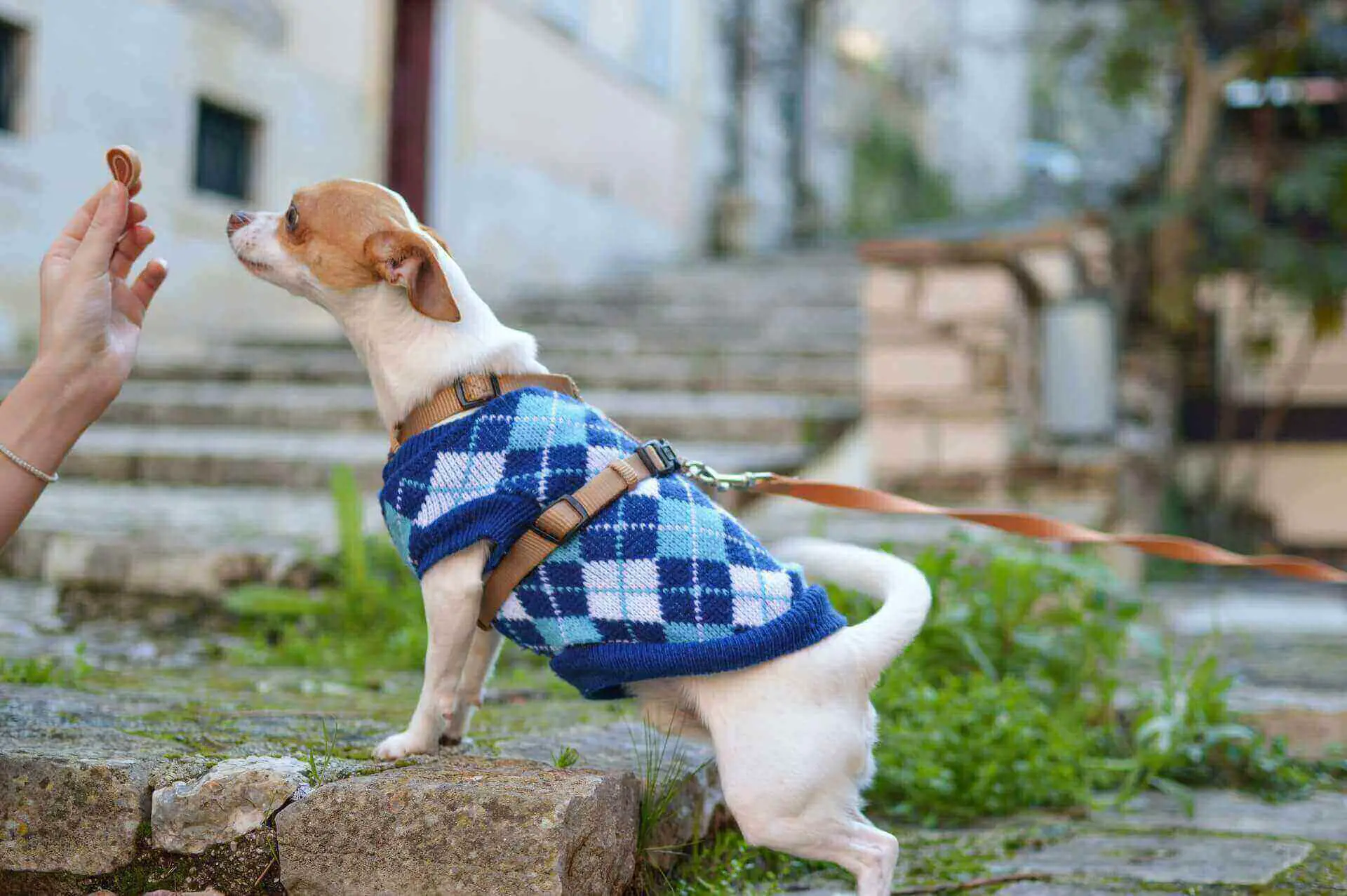Snow-time also means show-time for most pets! They just love rumbling in the mushy whites. But, it causes the formation of ice balls at the feet. Here, we have bundled all the advice on how to get ice balls off dogs paws.
To start with, we need to pay attention to our pet’s likes and dislikes. Do not force them if they do not like to go outdoors in winter. Take care. Among other precautions, you must know how to remove snowballs from dogs paws.
What Are Ice Balls or Snow Balls? How Do They Form In Dog Paws?
Ice balls are solid, globular formations of icy deposits at the feet of the dog. These can be very painful to walk. They can also cause bruises, abrasions, and cuts at the soft regions of the paws.
Your pet will exhibit signs of discomfort. She may refuse to walk in the snow. Sometimes they resort to vigorous chewing and licking of the paws. You may also find your pet limping. For all these reasons, it benefits you to know how to get ice balls off dogs paws.

Don’t worry. It is a temporary problem that gets well with proper care. What causes these to form though?
It happens due to molten snow that solidifies in the cold. They form deposits between dog toes and stretch the spaces between them. As your dog licks her feet, the problem intensifies because the saliva adds to the freezing mix. Follow the suggestions mentioned here on how to get ice balls off dogs paws.
In winter, people use salt to melt snow. You can find them everywhere, in driveways, or by the roadside. This salt gets into the bruised paw-pads of your pet. It causes a burning sensation that further aggravates the problem.
Dogs have sweat glands on their paw pads. This is why all dogs suffer from this problem. It is especially severe in furry breeds. Their paw-furs get mingled with the snow, escalating the issue.
Grooming the extra fur from their feet is a good way how to keep snow out of dog’s paws. We will tell you more about that later, but first, let us cover some basic ground.
How To Train the Dog For Snow Even Before Leaving Home?
Getting a pup to feel snow for the first time can be a great experience. Their expressions are so adorable that many pet owners decide to get it on video. You need to adapt with certain precautions though.
Most importantly, look for the well-being of their feet. You have various options on how to get ice balls off dogs paws. One of them is to train your pet to wear dog booties. If you are wondering how to protect dogs feet in snow permanently, this is a sure way to do that.
How To Train the Dog Into Wearing Boots?
Here, we will primarily cover how to train with dog boots. The same rewarding system is useful for other types of snow training as well. Remember to have patience.
- Introduce your pet to the booties. Keep them in his play area. Let him sniff the boots to know that they are good things. Also, reward him with a little bit of treat for showing interest in the boots. He must know that it’s a rewarding experience for the boot to touch his body. Do this for at least three days.
- Instruct him to lay down. If your dog is well-trained, you can also tell him to extend a paw. Put a boot on his front paw (or on the hind leg), tie it and let him be. You can also choose to tie two of these.
- It is best to designate a special area in the house for this training. It should be a quiet zone freed from distractions.
- Give him time to adjust to this new thing. It is very adorable to see them walk funny. Reward him with a treat when he stops trying to get it off. Follow steps 2, 3 & 4 for at least two days.
- On day six, put on all four boots. Do not take them off even if he tries to implore you to do that. Give him a greater reward for keeping all four of them on his feet.
- At any stage, do not scoff or scold him. It will make him dislike the accessories. Once he has grown fond of them, you can stop giving the rewards.
- After you have practiced walking indoors, continue it outdoors in the snow. Cover short distances at first. Eventually, go for longer walks. Dog boots help by offering a solution to how to get ice balls off dogs paws
How Should I Get My Dog Out In The Snow?
I repeat, do not push your pet in the snow if he does not like it. Even for those breeds that love frolicking in the swishy white powder, do not over-stretch it.
You will also have to know how to get ice balls off dogs paws. On this note, always keep a dry towel handy. Wipe the snow off your dog’s fur after playtime is over. Anxious pet parents ask, “why does snow stick to my dog?”
It’s because their furs tangle up with snow. Although your pet may shake himself dry, yet there will still be some residual white powder. Make sure that you wipe it off thoroughly.
Some pet owners inquire if it is right to use blow dryers to remove snowballs from dogs paws. It seems like a very convenient way how to get ice balls off dogs paws. However, it is not advisable to use the dryer with full heat.
Use the minimum heat settings from a distance. If the soft pad is getting reddish, it means that the heat setting is not appropriate.
Apart from this, you will also have to potty train your dog in the snow. Another thing, teach your dog not to eat anything off the ground. They might ingest some of the anti-freeze applied on the snow and suffer from an upset tummy.
Do Dogs Need Protection From Snow?
Some folks may think that the natural coats of the dogs offer them all the cold-protection they need. Well, it does, but mostly when the fur is dense. Breeds such as Alaskan Malamutes, Tibetan Mastiffs, and Newfoundland have thick coats.
They may not need an extra layer of coating unless they are very old. Smaller breeds like Chihuahua need it. Lean animals like Greyhounds also appreciate it if you put a jacket on them.
That said, all pet owners should invest in a dog coat. Lest the weather gets biting cold, you will need it. Also, all pet parents should know how to keep snowballs off dogs feet.
A general rule of thumb is, if it is too cold for you, the same is true for your pet. They may also suffer from frostbite or hypothermia. If your pet is breathing heavily and showing signs of distress, take care to warm him up.
We already discussed a remedy on how to get ice balls off dogs paws. Another popular method of avoiding ice formation is to rub petroleum jelly on the paws. However, you should consult your vet first on this. If they ingest the gel, it might not bear well with their tummies.
In case your dog prefers to stay inside, do not skimp on playtime though. The pent-up energy can show up as nervous or erratic behavior. Find out ideas for fun indoor games with your pet.
What To Do After Ice Balls Form In Your Dogs Paws?
Do not show your anxiety. They get more disoriented if you panic. Follow the tips described here on how to get ice balls off dogs paws.
Try carrying him to the car if your pet has a sore foot. Once you get to home, here is a simple remedy to remove snowballs from dogs paws.
You will need a few ingredients. First, get good quality sea salt. Avoid table salt because it contains processing chemicals. Next, you should get some bags of chamomile tea.
Chamomile is a healing herb that is safe for pets. Also, you will need a good quality aloe vera gel. Prepare the concoction by adding chamomile to warm water. Let it mix well for five to ten minutes.
Spread the towel on the floor. Take the dog’s paws and gently dip in the warm water. You can also wipe their feet with a soaked towel. Once you see the ice balls gone, wipe the feet dry.
Add aloe gel in the end. Don’t worry if your pet licks it. Practice this regularly to offer relief from ice burn on dogs paws. It is a simple, yet effective method of how to get ice balls off dogs paws.
How To Avoid Ice Balls Or Snow Balls Forming In Dogs Paws In The Future?
It’s important to understand that formation of ice balls is not any kind of disease. It is a natural phenomenon that is inevitable when your pet trods the snow.
The only way to avoid it totally is to habituate the pet into wearing booties when they go out in the cold. Special paw balms are also available that help with how to get ice balls off dogs paws.
At all times, pet owners should direct sufficient care to the well-being of the paws. These are special organs that help the animal to move about freely.
According to a Japanese researcher, the canine paw has a special circulatory system. This research found out that paws consist of a close proximity of arteries and veins. This permits prompt heat exchange.
Even then, not all breeds have equal tolerance to cold. You should be well aware of the different remedies to remove ice balls in dog’s foot pad.
Trim Paws And Nails Regularly In The Winter
Regular pet grooming offers an easy solution to how to get ice balls off dogs paws. You can also take help from a professional groomer.
Dogs have fur in between their paw pads. It gets tangled with snow eventually leading to ice balls. Trimming the fur regularly minimizes the risk.
You should also check the nails. Snow can get stuck below big nails. If you hear a lot of clicking sound when your pet walks on the floor, it means that the nails need a cut. Use a nail cutter or a dremel bit to keep them to the right size.
Apply Natural Dog Paw Wax Or Paw Balm
Are you thinking how to get ice balls off dogs paws without using booties? This product acts as ‘invisible boots’. Many pet owners highly recommend it.
Nonetheless, it has a few disadvantages. Decide for yourself.

| Pros | Cons |
| Made of natural beeswax | Some dogs can be allergic to it |
| Protects the paws from snow and ice | Can cause the pet to slip and fall on hardwood floors |
| Food-grade wax, non-gmo, gluten free | Can clog sweat glands |
| Easy to apply | Apply in moderation, excess use is not advisable |
Use Dog Boots With Waterproof Shoes
We already discussed how to train your dog into wearing booties. These wonderful boots can well provide a solution to how to keep snow off dogs paws.
They are waterproof and hand-washable. The velcro straps make it easy to adjust the tightness. They feature a wide-split seam top opening. This makes them easy to slip on the paws.
These skid-resistant booties are great options on how to get ice balls off dogs paws without using a gel. Besides, they look incredibly smart.
Cleaning Dog Paws In A Bowl Of Warm Water
Keep a bowl of warm water at your doorstep. Dip the paws of your pet one-by-one. Wipe the paws thoroughly. It is, by far, the simplest way how to get ice balls off dogs. Learn to pet your dog the right way while doing this, so it becomes an easy experience.
Use Pet Safe Ice Melt In Your Home
Using a pet-safe ice melt is a good way to prevent the deposit of snow on dogs legs. Nevertheless, it may not entirely prevent the formation of ice balls. But, it is still a good preventive measure to protect your dear pet from an upset stomach.
This product is highly effective. It can melt twice as much ice as rock salt even at 21 degrees Fahrenheit. They make it with Magnesium Chloride harvested from the Dead Sea. This compound has very low levels of toxicity.
It’s an eco-friendly product that won’t harm plants. Neither does it affect driveways as long as the concrete is properly set and cured.
Frequently Asked Questions
Check out these FAQs on how to remove snowballs off dogs paws. We have tried our best to answer all questions in this matter.
Is It Okay To Walk Dogs In The Snow?
Most dogs enjoy walking in the snow. However, you should apply your wisdom as to how much time you should stay outdoors.
Apply proper precautions mentioned in this article. Also, take caution when you are taking your dog off the leash in winter. Their sense of smell gets disoriented in the snow. They might get lost in the great outdoors.
Are Dogs Paws Ok In The Snow?
Some dogs have very tough calluses on the paws. Others have soft under-paws. However, all breeds have to deal with the typical problem of the formation of ice balls.
How Long Can I Let My Dog Play In The Snow?
Extending snow play for more than half an hour at a time can get your dog to catch cold. Also, don’t assume that since your pet has a thick coat, she is immune to cold. This is a myth. Even sled-dogs need protection from the snow.
Never let a dog out in the snow for the night, no matter the breed. The same goes for leaving them inside cars in winter. Closed vehicles can act as refrigerators, freezing the trapped animal.
Use protective gear like winter coats, ultra paws leg wraps for dogs, and dog booties. Amazon is a great place to shop for all things dog.
How To Prevent Ice Balls From Forming On Dogs Paws?
If you want to avoid it permanently, use doggo booties. Application of special paw balms also helps in preventing them. Trimming the fur at the paw region minimizes the problem.
How To Get Relief From Ice Balls?
Practice the suggestions mentioned here on how to remove snowballs from dogs paws. For after-care, you can give your dog a foot-bath using warm water.
Can You Put Coconut Oil On Dogs Paws?
Yes, you can. Coconut oil prevents irritability at their paws. It is also a good remedy for sore paws. That said, you should always keep a lookout for whether your pet has an allergic response to it.
What Can I Rub On My Dogs Paws?
Remedies made of natural beeswax can be good for their paws. We already mentioned where you can get it.
Should You Moisturize Your Dogs Pads?
Yes, you should. Do not use moisturizers made for human use though. You can get pet-friendly products online.
Takeaway- How To Get Ice Balls Off Dogs Paws
“How to protect my dogs paws in the snow?” It is a common question. For complete protection, train your pet to wear booties. It keeps their feet dry and protected.

Using a good quality paw balm also works. However, be careful to keep its use to a minimum. Otherwise, your pet may slip on hardwood floors. For after-care, give them a foot sauna with warm water.
Enjoy a cozy winter with your pet. And, keep an eye on their food ingredients to keep them healthy. They may have a tendency to like cat food in winter. Keep them away.

Welcome to Learn About Pet. My name is Rajkumar Ravichandran and I love all pets, travel, and amazing food. I write about my passion and personal experience caring for multiple pets in this blog! ❤️
Post Disclaimer
DISCLAIMER: THIS BLOG OR WEBSITE, "Learn About Pet", DOES NOT PROVIDE YOU WITH MEDICAL ADVICE AND IS NOT A SUBSTITUTE FOR MEDICAL ADVICE. ALWAYS GET IN TOUCH WITH YOUR PERSONAL VETERINARIAN AND USE INFORMATION HERE AS GENERAL ADVICE.
The information, including but not limited to, text, graphics, images and other material contained on this website are for informational purposes only. No material on this site is intended to be a substitute for professional veterinary advice, food recommendation, diagnosis, or treatment. Always seek the advice of your veterinarian or other qualified health care provider with any questions you may have regarding a medical condition or for pet food related questions.







